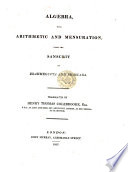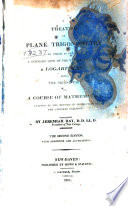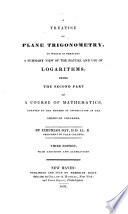 | Thomas Simpson - Calculus - 1750 - 304 pages
...2ab-\-2cd ; and confequently, the Square of the Area = — — X X b+ — d— <: _ which ( becaufe the Difference of the Squares of any two Quantities is equal to a Re&angle under their Sum and Difference) will alfo be=: b+a H*Hf*+f«~^. Whence it appears, that,... | |
 | Charles Hutton - Ballistics - 1812 - 412 pages
...multiplied by the quotient, is the square of the first number. llM, The difference of two squares, is equal to the product of the sum and difference of the roots. 12th. If two numbers be divided by each other; and the quotients multiplied together, the result... | |
 | Jeremiah Day - Measurement - 1815 - 388 pages
...to the square of its diameter multiplied into .7354. (Art. 30.) And the difference of these squares is equal to the product of the sum and difference of the diameters. (Alg. 235.) Therefore the area of the ring is equal to the product of the sum and difference... | |
 | Algebra - 1817 - 478 pages
...been taken from each : for any two quantities, less an equal quantity, have the same difference. It is equal to the product of the sum and difference of the simple quantities. Therefore the sum of the sides, multiplied by their difference, is the difference... | |
 | Brahmagupta - Algebra - 1817 - 488 pages
...difference, the quotient is the sum of the upright and hypotenuse. For the difference of the squares is equal to the product of the sum and difference of the roots. (§ 135.) The upright and hypotenuse are therefore found by the rule of concurrence' (§ 55).... | |
 | 1818 - 590 pages
...be resorted to. This property of triangles, that the product of the sum and difference of the sides is equal to the product of the sum and difference of the segments into which the base is divided by the perpendicular, is found in the Lilavati, § 163, and... | |
 | Asiatic Society of Bengal - Archaeology - 1818 - 642 pages
...multiplied by the quotient is the square of the first number. " 1 1th. The difference of two squares is equal to the product of the sum and difference of the roots. " 12th. If two numbers are divided by each other, and the quotients multiplied together, the... | |
 | Peter Nicholson - Architecture - 1823 - 210 pages
...BC*- CD*=BD*. Subtract the second equation from the first, and the result is AC*-BC*=AD*-BD* : but, since the difference of the squares of any two quantities is equal to a rectangle contained by their sum and difference ; therefore (AC+BC)(AC -BC) = (AD+BD) (AD -BD) Whence,... | |
 | Jeremiah Day - Geometry - 1824 - 440 pages
...squares may be obtained by logarithms. It depends on the principle, that the difference of the squares of two quantities is equal to the product of the sum and difference of the quantities. (A|g. 235.) Thus as will be seen at once, by performing the multiplication. The two factors... | |
 | Jeremiah Day - Logarithms - 1831 - 418 pages
...squares may be obtained by logarithms. It depends on the principle, that the difference of the squares of two quantities is equal to the product of the sum and difference of the quantities. (Alg. 235.) Thus, ha-b'=(h+b)x(hb) as will be seen at once, by performing the multiplication.... | |
| |